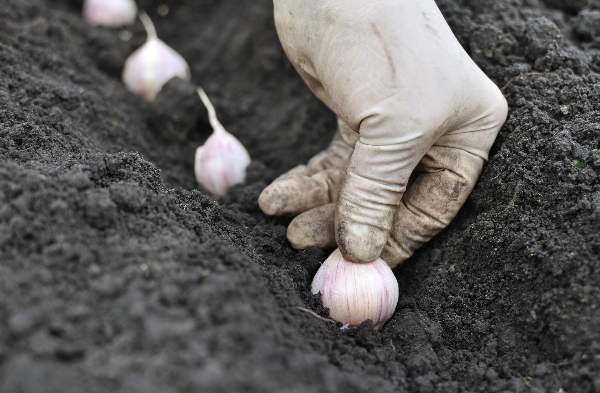The best vegetables to grow in autumn

Autumn can be a tricky time of year if you’re an avid gardener – the chances are that you may have harvested the majority of your veg in summer and you probably won’t consider planting any more until spring.
However, believe it or not, there are plenty of vegetables that can thrive during winter, with some even requiring the cold to grow and mature successfully.
Instead of abandoning your allotment for the season, instead I would recommend embracing the cold and making the most out of the delicious vegetables that can be planted and will survive until spring!
Garlic

A potent herb with a pungent odour, garlic is incredibly popular, being mixed into everything from pasta sauces to chilli. This is with good reason – behind its strong smell, garlic is a powerhouse of nutrients, including antioxidant compounds such as allicin and the bone-boosting mineral calcium.
This means that garlic has accumulated quite the reputation for preventing colds and flu, with our own founder, Alfred Vogel, remarking that garlic had a “rejuvenating effect on circulation as well as boosting our immune system.”
It’s also surprisingly easy to grow, with many citing autumn as the best time to plant garlic. The herb requires a cold period to grow and should be ready for harvesting in spring. They’re not a difficult plant to care for but they will require light soil and plenty of compost or manure to thrive. Weeding is absolutely essential for their survival – they can easily become suffocated! – and it might also be an idea to try and protect them from any curious birds too!
Onions

Onions are very similar to garlic in that they contain many of the same compounds, such as quercetin.
Highly adaptable, they can appear in dishes ranging from salad to soup, and they’re chockfull of health benefits, including vitamin C and chromium to help regulate blood sugar. Onions are also a natural anti-inflammatory as well as containing antioxidant properties.
You can sow onions in mid-autumn or winter. I would recommend planting the seeds between September and November in sets to help avoid disease. Planting in sets simply refers to sowing miniature bulbs rather than seeds – this can make for an easier growing experience if you are new to planting onions.
If you are sowing them in sets, your onions should be read to harvest by early summer, somewhere between May and July.
Spinach

Made famous by Popeye, spinach is an excellent green leafy veg to have growing in your allotment. It’s naturally rich in vitamins A & K, making it great for supporting your bones and digestion. Spinach also contains more potassium than bananas so it’s definitely not a plant to overlook.
It’s great at enduring cold temperatures, and can thrive in damp (damp, not soaking) soil. You can plant spinach in September and it should be ready to harvest quite quickly, usually between January-March.
However, you may need to protect your seedlings from the elements during the harsher winter months and keep a watchful eye out for pests such as slugs and snails! For more information, please have a look at our guide to growing spinach.
Brussels sprouts

Brussels sprouts are a favourite during the festive season, resembling miniature cabbages. Unsurprisingly, the two vegetables do share a connection and Brussels sprouts are just as jam-packed full of goodness as their older cousin.
For a start, they’re full of fibre and vitamin K, helping to maintain and support your digestive system. The high vitamin C content of Brussels sprouts also makes them useful when it comes to your production of collagen and protecting the immune system.
They’re good at coping with colder temperatures, although they can take anywhere from 12-24 weeks to mature and will require treatment with fertiliser. I would recommend planting the seeds from September-October. This may ensure that you get a yield just before Christmas, or in early spring!
Turnips

Turnips are a famously hardy root vegetable that can be incorporated into a variety of warming winter dishes. Unlike the other plants on this list, which you can harvest in spring, providing you plant turnips in early autumn, you may be able to produce a yield by December/January.
This is because turnips can grow rather quickly, even in colder climates, sometimes maturing within 6-10 weeks! They’re not demanding vegetables to care for either, requiring only the basics such as regular water and protection from the elements in extreme cases, and the usual pests.
When harvesting, I would recommend eating the leaves too – not only are they tasty, they’re also extremely nutritious!
Lettuce

Lettuce is a common ingredient in summer salads, so it may surprise you to learn that you can nurture it through winter. Some varieties will naturally fare better than others, so I would go for a good winter lettuce such as ‘Artic King’ or ‘Winter Gem.1’
Although not all of these varieties are suitable for cultivating outdoors2, they will flourish in an unheated greenhouse! You can start sowing your lettuce seeds between August and October, making sure you choose a plot with some shelter. Condition the ground with compost before planting and ensure that your lettuce seeds are protected from the elements when necessary.
1https://search.thompson-morgan.com/seeds/Winter-Lettuce
2https://www.thompson-morgan.com/p/lettuce-winter-gem-cos/999TM





 Looking for our products in a store near you?
Looking for our products in a store near you?

